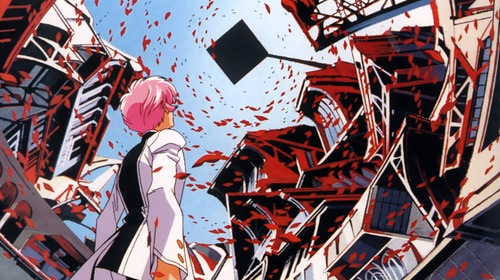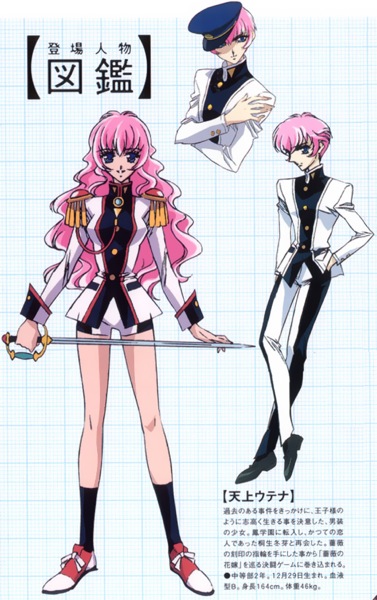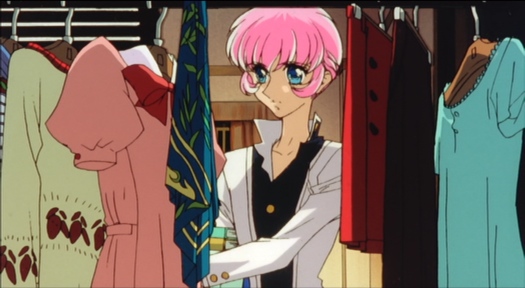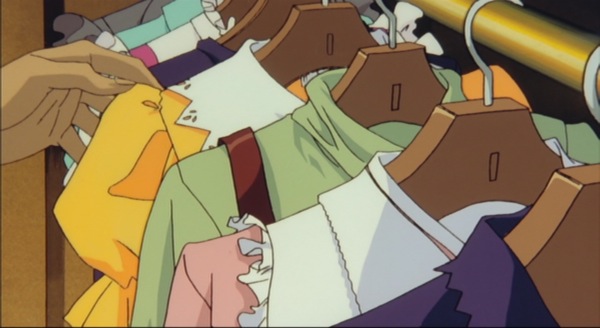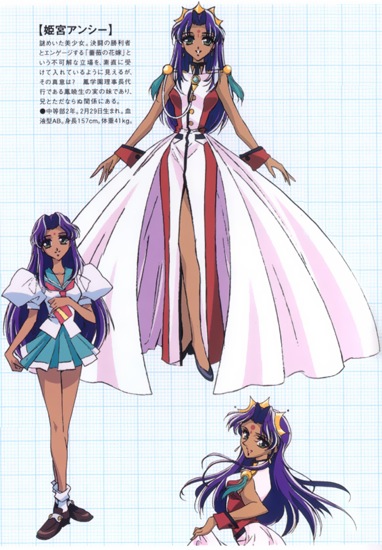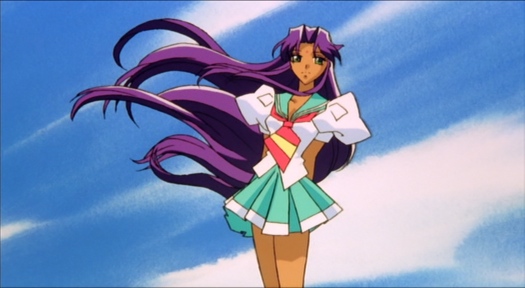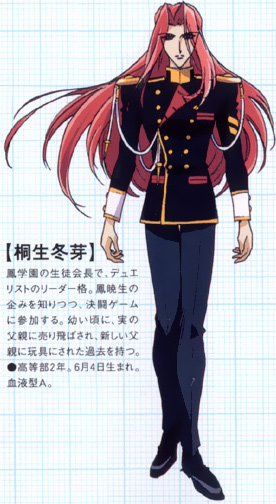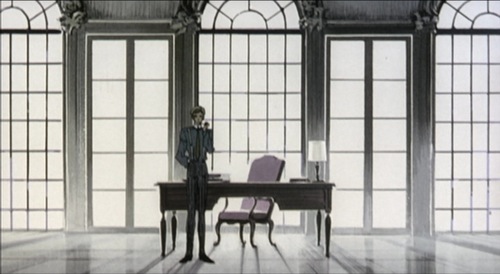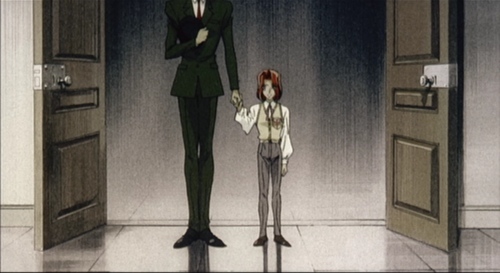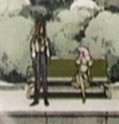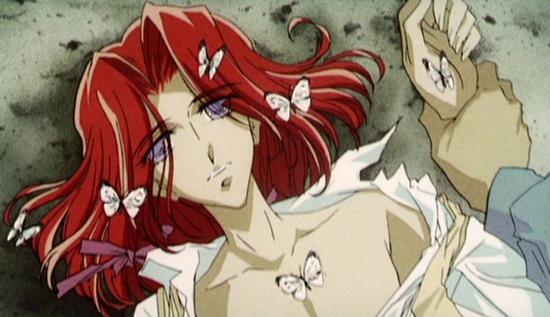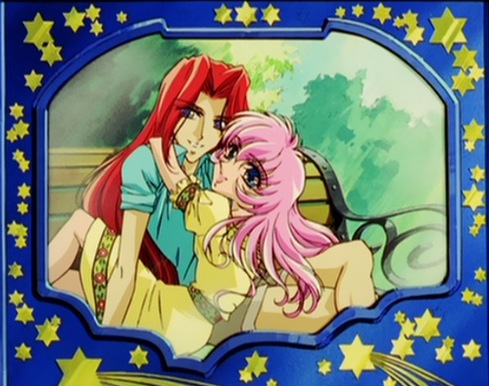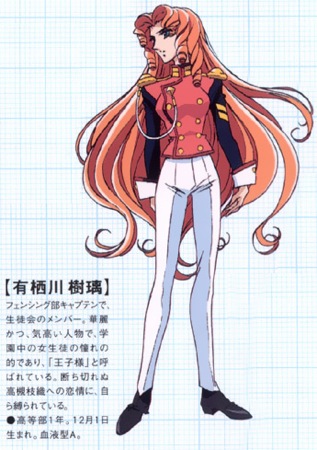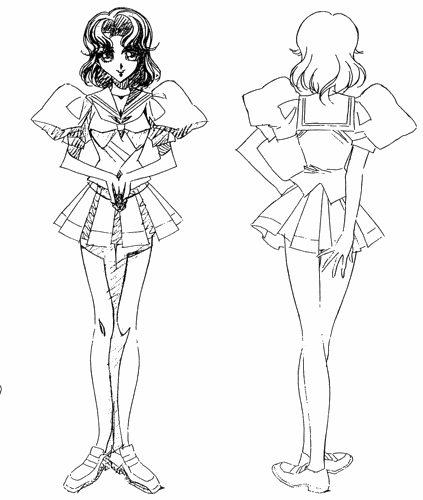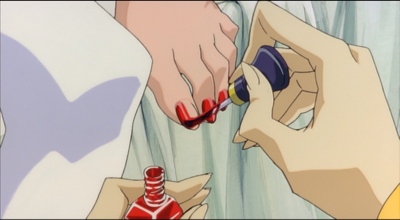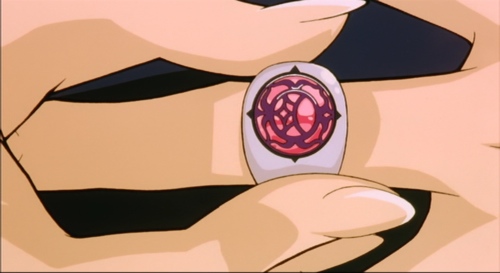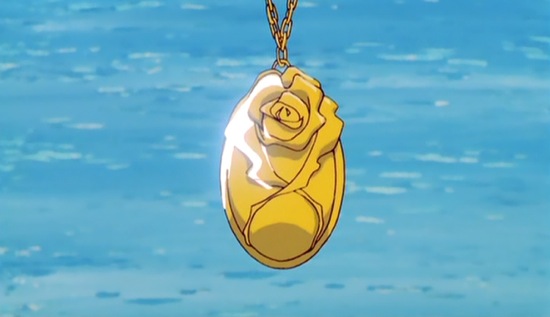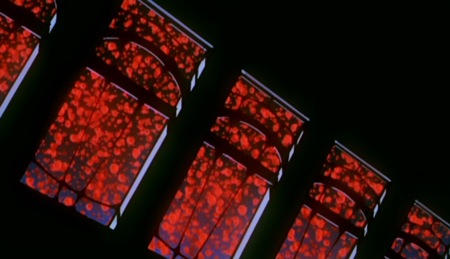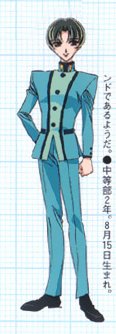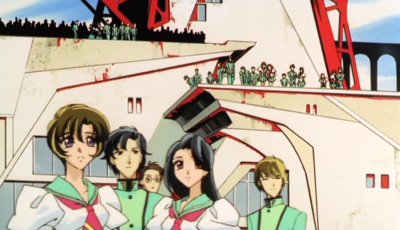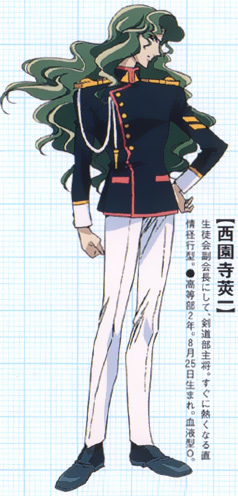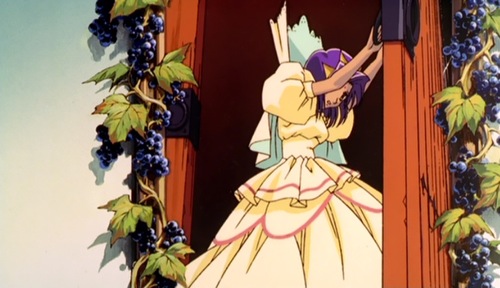|
Revolutionary Girl Utena: The Movie
Revolutionary Girl Utena: The Movie (Ikuhara, 1999) Welcome to Ohtori Academy, school of roses, revolution and rebirth. Utena Tenjou, Ohtori's newest student, dresses like a boy but looks like a girl. Her mysterious past, and yet-unfulfilled ambitions, lead her to cross-dress. By degrees, Tenjou is led into a strange game, where members of the student council duel to possess Anthy Himemiya, a comely, subservient "rose bride." Whoever wins enough duels gains "the power of world revolution." Enter into this mess the idea of a prince. Utena has resolved to become noble and valiant, just like the prince she lost in childhood. So what happens when her prince reappears at the school? And what if he is the key to understanding these mysterious duels, and the mysterious "ends of the world"? This film is "Cinderella in Japan on acid on crack," as one friend put it. If you've seen the film, you know how strange it is, and how open to interpretation. It's also sometimes hard to keep track of the characters. Here's a hair-color-coded guide: Utena = Pink Hair Please be advised that this film covers some disturbing material. There is one scene where rape is shown, and another where it is strongly implied. Revolutionary Girl Utena is, in many ways, a story told through clothes. Every sartorial detail, from a ribbon to a button to a shoe, tells us something which makes a difficult story more comprehensible. If you haven't seen the television series, or read the manga, don't despair. I'll walk you through the character designs, and then we'll talk about the movie on its own merits. Don't be frightened! The Main CharactersUtena Tenjou
Our protagonist, Utena Tenjou, has pink hair and blue eyes. Her hair is cut in a short, boyish crop with bangs. She is about fourteen years old, but has no trace of baby fat: her legs are long and slim, her face angular and androgynously mature. Utena dresses in a modified boy's uniform, a gakuran of alternating white and blue-black panels. The gakuran is fastened by large gold buttons up the front. The cuffs are fastened by two buttons. In some scenes, Utena wears a navy blue sailor's cap with the Ohtori rose crest on the front. Her shoes are black dress shoes. When Utena changes into her duelist uniform, her hair lengthens and her breasts enlarge. In one scene, Saionji slashes her jacket, revealing cleavage underneath. Her breasts are (presumably) constrained under her uniform, leading to a more androgynous silhouette, especially given her V-shaped body. Tenjou's duelist uniform differs from her school one. You can see it in the above picture on the left. It is a skintight military jacket with shorts underneath. This jacket has a fastened standing collar, red trim, red epaulettes with golden shoulder tassles and a red aiguillette (ornamental braid from collar to shoulder). Her shoes are two tone dress shoes with a white toe and heelcap, and a red vamp, with a ribbon but no visible lacing. She also wears black, calf-length socks.
In one scene, we see Utena open her closet. Her clothes, you'll notice, are cutesy, feminine and terribly old fashioned. They might suit a six-year-old girl, but not a fourteen-year-old one. Rich people dress their daughters in these types of dresses when they want to show them off. The colors are all wrong for Utena's, possibly anyone's, complexion: pumpkin orange, greenish beige, deep red, turquoise...in what context did Utena wear these outfits? The movie gives us ideas, but not answers. Anthy Himemiya
Anthy Himemiya is the Rose Bride. Those with a rose signet duel with swords to possess her. Whoever succeeds may be granted, through her, an obscure "power to revolutionize the world." As the Rose Bride, Anthy tends to Ohtori Academy's immense rose garden. This rose garden is a large rectangle that towers over the campus; when she wants, she can send cascades of roses and rose petals tumbling over its sides. Anthy Himemiya rules Ohtori Academy. Although she "submits" to the will of whoever wins her, these duelists take the path that she wants them to take. Classics scholars may recognize "Anthy" as a derivative of "Antheia," a Charite in Greek mythology. Antheia was a goddess of flowers and flowery wreaths.
Anthy looks south asian (Indian, Pakistani, Sri Lankan, etc). Her skin is dark and she wears a red bindi on her forehead. Her brother, Akio Ohtori, has a similar complexion. Utena's co-creator, mangaka Chiho Saito, is purportedly fond of Indian culture and characters. Since Anthy and Akio's race is never commented on, it's up for interpretation why they're drawn this way. In class, Anthy wears the typical Ohtori seifuku. Her rose bride dress, however, is a tight-fitting, military-influenced dress with a large overskirt opened in the middle. The dress has white along the middle of her body, with two panels of red fabric along the outside of her bust, hips and legs. She also wears detached red cuffs with black buttons and trim. Like most of the dress uniforms, Anthy's includes epaulettes, but with sea-green tassels instead of auiguilettes, and with gold spheres at the ends. In one scene, we see Anthy wearing a very frilly white dress with a pink apron over it. Here she is with her brother Akio, the "prince." Touga Kiryuu
Touga Kiryuu died before this movie began. He saved a young girl from drowning, but drowned himself. The girl he saved was Juri Arisugawa, about which more later. Utena and Shiori both loved him; when he died, they reacted in radically different ways. Touga appears in the movie as a ghost of the past, interacting with Utena, Shiori and, briefly, Anthy. Despite the passage of time, Touga still looks older than Utena and Shiori; they're about fourteen, he about seventeen. He makes a very mature seventeen. Kiryuu has long, firetruck-red hair and light purple eyes. He is rather beautiful, and tall. Unless he is naked, present-day Touga wears a black, double-breasted military jacket with gold trim, red lining and white cuffs. His epaulettes have no tassles but he has a white aguillette and two fourrageres (decorative braids that go under the armpit). This busy top is offset by a pair of plain black slacks and shoes. Black suits him, and his jacket emphasizes his broad shoulders and narrow waist. Touga was adopted as a child. In a flashback, we see him arriving at a mansion; a faceless, suited agent holds his hand and leads him down a vast hallway to a drawing room, where his new father smokes a pipe and greets him with the world's creepiest smile.
Touga's "father" wears tailored, classic menswear: a green-gray shirt, with a narrow white collar, a contrasting olive tie and pinstriped pants with white suspenders. The impression is very old money, and old fashioned; his outfit belongs to the 1930s, not the 1990s. Touga wears a white shirt, a cream colored sweater with a fleur-de-lis insignia on it, gray pants, a black belt and black shoes. His shirt appears to have a soft collar and bishop sleeves. He wears a red ribbon bow under his collar, instead of a tie. Touga's clothes indicate that whoever gave him away––an adoption agency, a relative, another "customer"––belongs to the same world as his new father. This, coupled with Touga's choice of words, implies that whoever sold Touga knew what would happen to him. Touga's petrified, thousand-yard stare hints that he may have endured previous "customers" with similar tastes. He wears this same outfit in a later scene:
This is the scene where Touga dies. He is somewhat older and his hair is longer ("that's what the customer wanted"). Why is he still wearing that outfit? Perhaps the customer wanted that, too.
In this scene, Touga's ribbon tie is broken discarded next to him, his shirt and sweater ripped open. His "father" leans over him, clothing intact, smiling unctously. Notice that Touga's ribbon is still tied in a bow. This boy may have been broken but he is not undone. In another picture, seen briefly in Utena's bedroom, we see an older Touga wearing an aquamarine polo shirt and khaki shorts:
Touga Kiryuu was on the cusp of puberty when he died. Would his nobility have survived the onslaught of hormones, from himself and others? His charisma, good looks and aristocratic background are a perfect recipe for corruption. In the anime, Kiryuu is a narcissistic playboy, with aristocratic manners that belie a cynical core, hinting at some deep pain. By dying, movie-Touga may have saved his soul from a similar fate. Juri Arisugawa
Touga saved Juri from drowning, but Juri let him die. She is also, irony of ironies, in love with Shiori, who resents Juri for Touga's death. Juri is a member of student council and the fencing team. She wears an orange, double-breasted military jacket with black sleeves, white cuffs and red trim. Her epaulettes are gold with no tassles; her aiguilette, cuffs and pants are white. Juri's orange hair cascades, in tight, vertical curls, along the sides of her face. Her eyes are green. Juri wears a gold locket with a rose insignia. We see the locket twice during the movie: once in Juri's introduction scene, when she loosens her fencing uniform, and once when Shiori comes to visit her in the student council area. The locket is briefly shown against a background of water, reminding us of how Touga saved her. Shiori says that Juri keeps a picture of Shiori inside the locket, but we never see it open. Shiori Takatsuki
Shiori Takatsuki may not control Ohtori, but she enforces its limits. As the "ends of the world," or "sekai no hate," Takatsuki can communicate with the ghost/spirit of Touga. Like Utena, she too loved Touga as a child; when he died, she took her resentment out on Juri. Shiori has plum-colored hair with purple eyes. She wears a variant of the standard SKU student uniform, with extra frills along the sleeves and collar. She wears brown loafers with ankle-length white socks.
Shiori and Touga meet in a room where all furniture is covered by white cloth. In their first scene together, Touga paints Shiori's toenails red––the color of his hair. This can be seen as an expression of submission or possession, since Touga owes his existence in Ohtori to the ends of the world. Red is Touga's color, the color of the roses and of much of Ohtori. MotifsWe now turn from the main characters to the movie at large. A few sartorial motifs thread through the film; they are discussed at greater length below. Roses
Revolutionary Girl Utena is dominated by roses. The signet which allows Ohtori students to duel has a stylized pink rose on it. In order to win the "Rose Bride," one must knock a rose off of the opponent's chest. Anthy tends a large rose garden as part of her duties. Red roses grow over Akio's grave, implying that he never existed. Even Juri's locket has a rose pattern on the front. At the end of the film, Utena and Anthy escape Ohtori in an explosion of red roses. So what does it all mean? The rose has taken on many, many symbolic meanings throughout history. It is a common symbol in heraldry as well as mythology. Its meanings are diverse, and can represent everything from virginity to death to love to silence. We see basically two colors of roses in the film: white (with a slight pinkish tint) and red. The stylized rose crest on the signet appears to be purple with a pink background. This white rose appears to represent Utena, since it is this rose that gives her the rose signet. White also represents purity, and a lone white rose against a backdrop of red ones shows individuality. Oddly, very few roses appear on clothing in this film. Save the rose signet, Juri's locket, and an insignia on Utena's sailor cap, there are very few roses to be seen. Sea Green
This loathsome color is the primary color in the normal Ohtori students's uniforms, and serves as a queasy contrast to red, which is a dominant color in the school's architecture. Military Dress
All of the student council uniforms have strong military themes. Their jackets have standing collars with brass buttons, epaulettes and cords. This is very formal, and brings to mind eighteenth-century military uniforms. In the final scene, Akio/Dios wears a white, military-style uniform with tails and epaulettes. Fairy Tales
Revolutionary Girl Utena is, partly, a deconstruction of the Prince Charming fairytale. The movie states, explicitly, that there is no prince, that there never was one to begin with; yet Ohtori revolves around the idea of princeliness. Red roses grow over Akio's grave, which contravenes the superstition that red roses won't grow over the dead. Implying that he never existed in the first place. In one flashback/dream sequence, we see Anthy and "The Lord of The Flies," a boyish figure with lavender-colored hair. In the anime, this boy is "Dios," a prince figure who fell from grace and turned into Akio. Anthy wears a frilly, poofy dress which calls to mind Cinderella, Sleeping Beauty and all the other princesses; The Lord of the Flies wears a white, military-esque uniform with a waist-length cape. What Does It All Mean?As a child, Utena fell in love with Touga. Despite, or perhaps because of, his abusive upbringing, Touga lived up to a high moral code. Utena admired him a great deal. Unfortunately, this personality trait led to Touga's untimely death. Touga jumped in to save Juri Arisugawa, but died in the process. Juri may have let him die. Touga's death affected Utena, Shiori and Juri in direct and devastating ways. Juri felt guilty for letting him die. Shiori, who was obsessed with Touga from a distance, decided to punish Juri, first for killing Touga, then for loving her. Utena resented Touga for dying, but she also decided to become a prince herself. Anthy's backstory differs from the rest. Her brother, Akio, used to drug her and rape her unconscious body. At least that's what he thought; sometimes she wasn't unconscious. When he found out she wasn't always asleep, his guilt made him commit suicide. Before killing himself, though, he stabbed her; evidently she survived. Ohtori allows these characters to keep from moving on with their lives. Their outfits, for all their formality and busy-ness, are a mirror to the fractured and wounded personalities within. In the film's last scene, Utena and Anthy lie, naked, on top of the rudimentary parts of a car, zooming through a gray landscape into an unknown future. It is only by shrugging off the clothing of their past, by literally becoming naked, that they can move on with their lives and embrace reality. Related Reading: Sources: Revolutionary Girl Utena - the Movie. Accessed via webarchive on 27 August 2010. Return to Enjoy Your Style's style in film section. Return to Enjoy Your Style's home page. Search Enjoy Your Style: |
Search this site:





